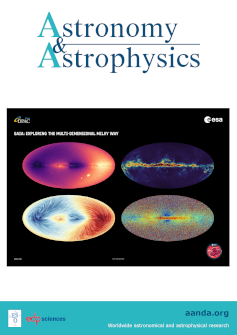Studying the variability of the He triplet to understand the detection limits of evaporating exoplanet atmospheres
IF 5.8
2区 物理与天体物理
Q1 ASTRONOMY & ASTROPHYSICS
引用次数: 0
Abstract
With more than a dozen significant detections, the helium triplet has emerged as a key tracer of evaporating exoplanet atmospheres. This near-infrared feature can be observed from the ground and holds great promise, especially with upcoming observations provided by new-generation instruments such as the Near Infrared Planet Searcher (NIRPS). However, as the helium triplet is also present in stellar spectra, careful removal of the average stellar contribution is necessary to accurately characterize the atmospheres of transiting exoplanets. In this study, we analyze multi-epoch observations of the Sun obtained with NIRPS to investigate the temporal variability of the helium triplet. Our findings reveal significant variability across different timescales, ranging from minutes to days. We identify telluric contamination and stellar activity as likely sources for the short-term and long-term variability, respectively. Importantly, we demonstrate that this variability has minimal impact on the retrieval of planetary parameters crucial to the study of atmospheric escape.研究氦三重态的变异性,了解蒸发系外行星大气的探测极限
经过十几次重大探测,氦三重态已经成为蒸发系外行星大气的关键示踪剂。这种近红外特征可以从地面观测到,并且前景广阔,特别是新一代仪器,如近红外行星搜索器(NIRPS)即将提供的观测结果。然而,由于氦三重态也存在于恒星光谱中,为了准确地描述凌日系外行星的大气特征,必须仔细去除平均恒星的贡献。在这项研究中,我们分析了用NIRPS获得的太阳多时期观测数据,以研究氦三重态的时间变化。我们的研究结果揭示了不同时间尺度(从几分钟到几天)的显著差异。我们确定大地污染和恒星活动分别是短期和长期变化的可能来源。重要的是,我们证明了这种变异性对大气逃逸研究至关重要的行星参数的检索影响最小。
本文章由计算机程序翻译,如有差异,请以英文原文为准。
求助全文
约1分钟内获得全文
求助全文
来源期刊

Astronomy & Astrophysics
地学天文-天文与天体物理
CiteScore
10.20
自引率
27.70%
发文量
2105
审稿时长
1-2 weeks
期刊介绍:
Astronomy & Astrophysics is an international Journal that publishes papers on all aspects of astronomy and astrophysics (theoretical, observational, and instrumental) independently of the techniques used to obtain the results.
 求助内容:
求助内容: 应助结果提醒方式:
应助结果提醒方式:


